2013 FORD F150 steering
[x] Cancel search: steeringPage 7 of 39
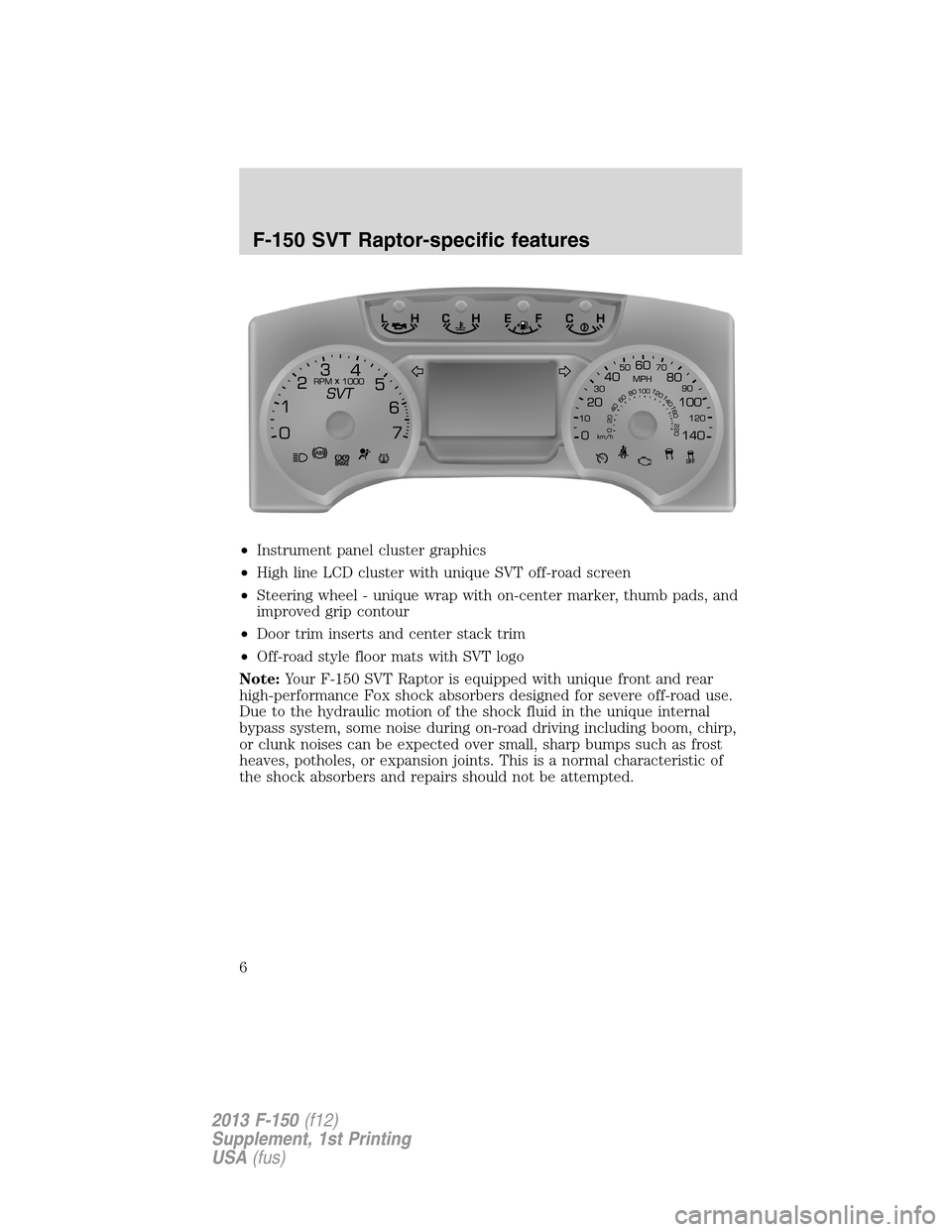
•Instrument panel cluster graphics
•High line LCD cluster with unique SVT off-road screen
•Steering wheel - unique wrap with on-center marker, thumb pads, and
improved grip contour
•Door trim inserts and center stack trim
•Off-road style floor mats with SVT logo
Note:Your F-150 SVT Raptor is equipped with unique front and rear
high-performance Fox shock absorbers designed for severe off-road use.
Due to the hydraulic motion of the shock fluid in the unique internal
bypass system, some noise during on-road driving including boom, chirp,
or clunk noises can be expected over small, sharp bumps such as frost
heaves, potholes, or expansion joints. This is a normal characteristic of
the shock absorbers and repairs should not be attempted.
F-150 SVT Raptor-specific features
6
2013 F-150(f12)
Supplement, 1st Printing
USA(fus)
Page 8 of 39
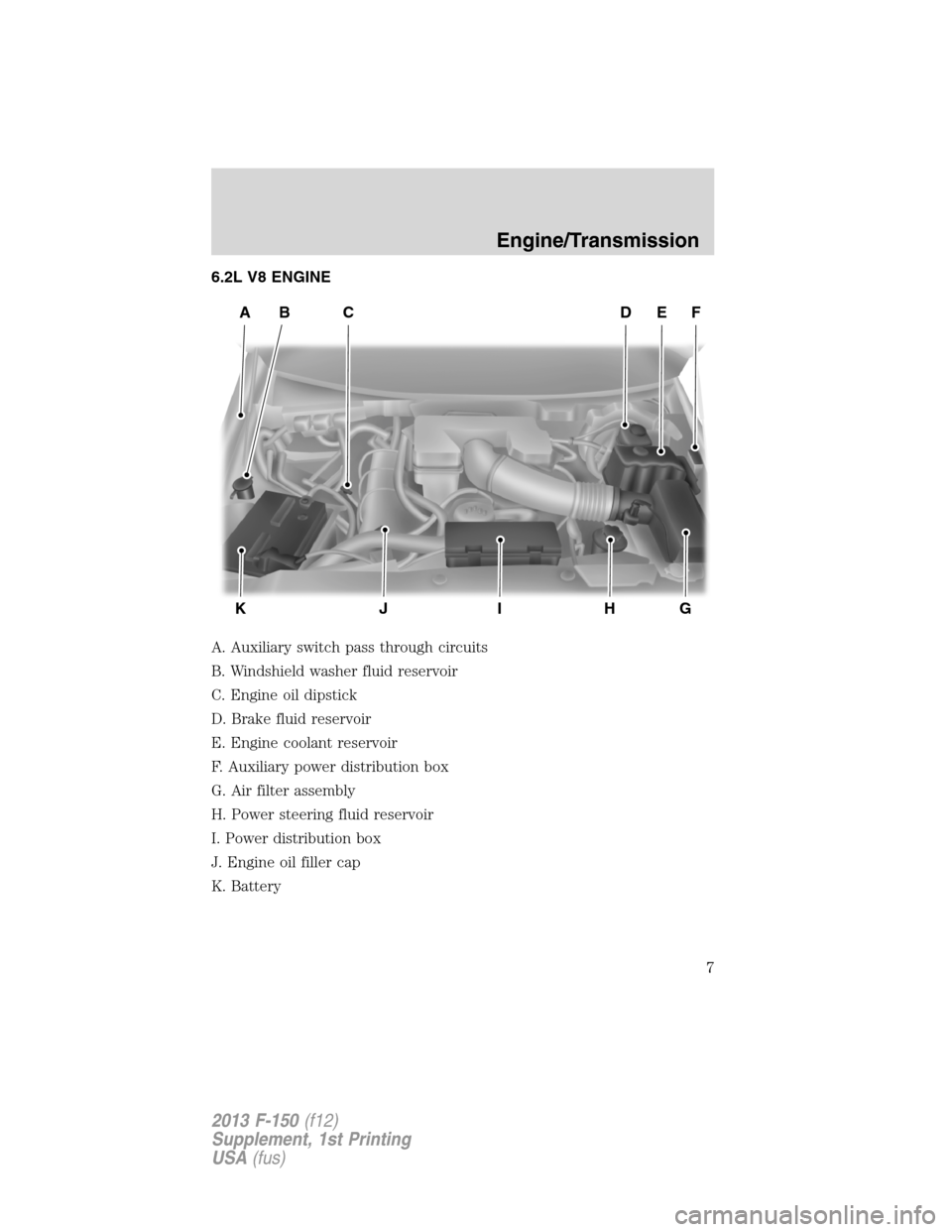
6.2L V8 ENGINE
A. Auxiliary switch pass through circuits
B. Windshield washer fluid reservoir
C. Engine oil dipstick
D. Brake fluid reservoir
E. Engine coolant reservoir
F. Auxiliary power distribution box
G. Air filter assembly
H. Power steering fluid reservoir
I. Power distribution box
J. Engine oil filler cap
K. Battery
CDEF
GHIJK
AB
Engine/Transmission
7
2013 F-150(f12)
Supplement, 1st Printing
USA(fus)
Page 13 of 39
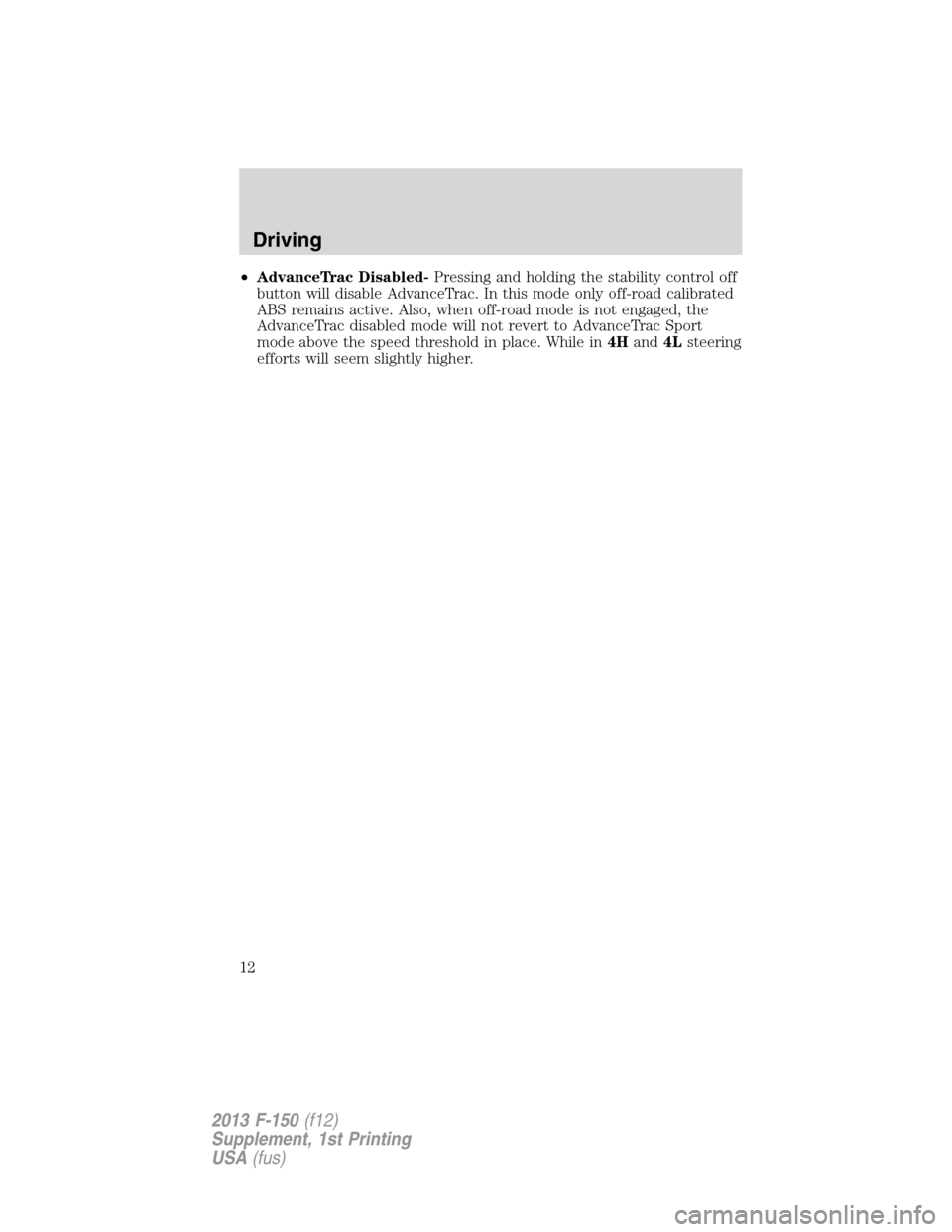
•AdvanceTrac Disabled-Pressing and holding the stability control off
button will disable AdvanceTrac. In this mode only off-road calibrated
ABS remains active. Also, when off-road mode is not engaged, the
AdvanceTrac disabled mode will not revert to AdvanceTrac Sport
mode above the speed threshold in place. While in4Hand4Lsteering
efforts will seem slightly higher.
Driving
12
2013 F-150(f12)
Supplement, 1st Printing
USA(fus)
Page 20 of 39
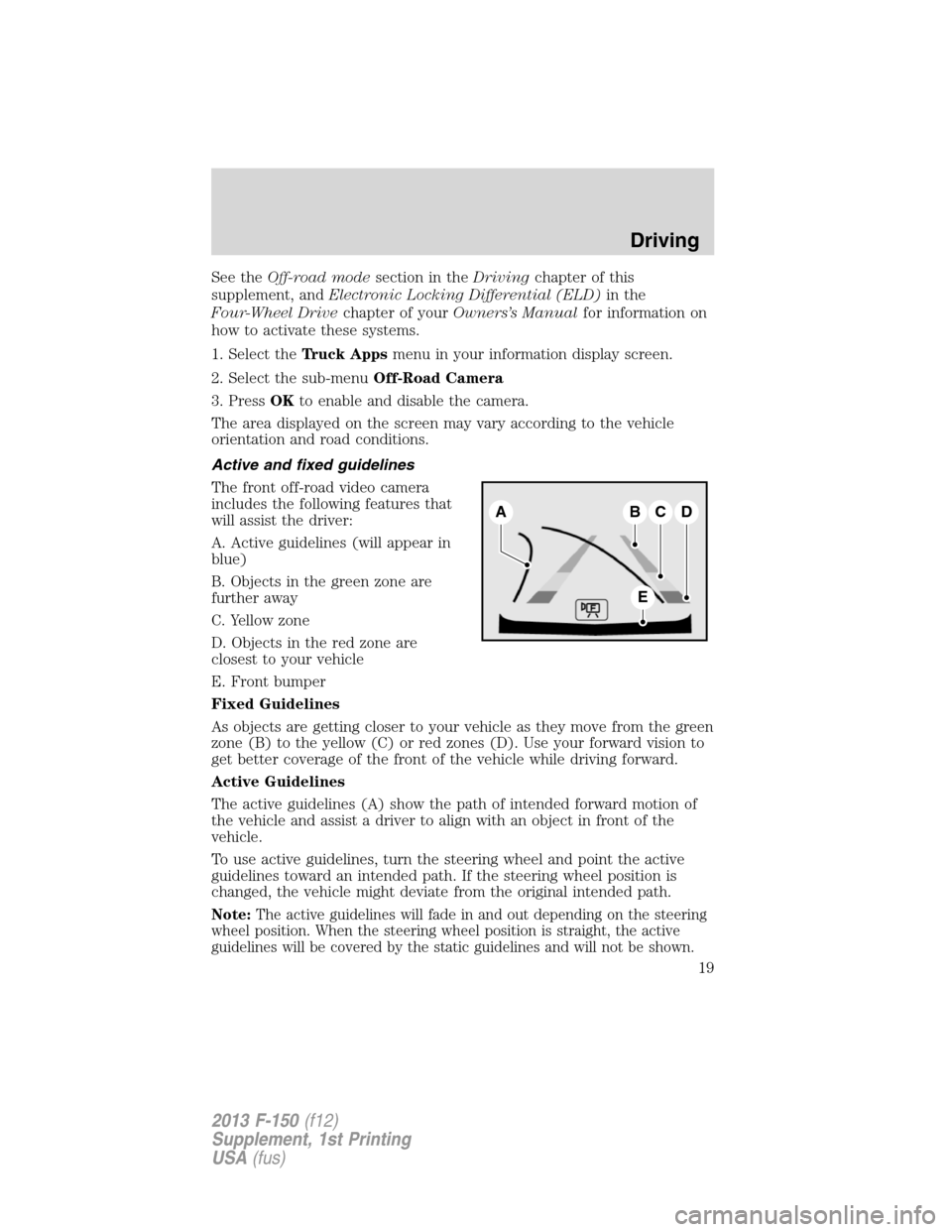
See theOff-road modesection in theDrivingchapter of this
supplement, andElectronic Locking Differential (ELD)in the
Four-Wheel Drivechapter of yourOwners’s Manualfor information on
how to activate these systems.
1. Select theTruck Appsmenu in your information display screen.
2. Select the sub-menuOff-Road Camera
3. PressOKto enable and disable the camera.
The area displayed on the screen may vary according to the vehicle
orientation and road conditions.
Active and fixed guidelines
The front off-road video camera
includes the following features that
will assist the driver:
A. Active guidelines (will appear in
blue)
B. Objects in the green zone are
further away
C. Yellow zone
D. Objects in the red zone are
closest to your vehicle
E. Front bumper
Fixed Guidelines
As objects are getting closer to your vehicle as they move from the green
zone (B) to the yellow (C) or red zones (D). Use your forward vision to
get better coverage of the front of the vehicle while driving forward.
Active Guidelines
The active guidelines (A) show the path of intended forward motion of
the vehicle and assist a driver to align with an object in front of the
vehicle.
To use active guidelines, turn the steering wheel and point the active
guidelines toward an intended path. If the steering wheel position is
changed, the vehicle might deviate from the original intended path.
Note:The active guidelines will fade in and out depending on the steering
wheel position. When the steering wheel position is straight, the active
guidelines will be covered by the static guidelines and will not be shown.
B
E
CDA
Driving
19
2013 F-150(f12)
Supplement, 1st Printing
USA(fus)
Page 22 of 39
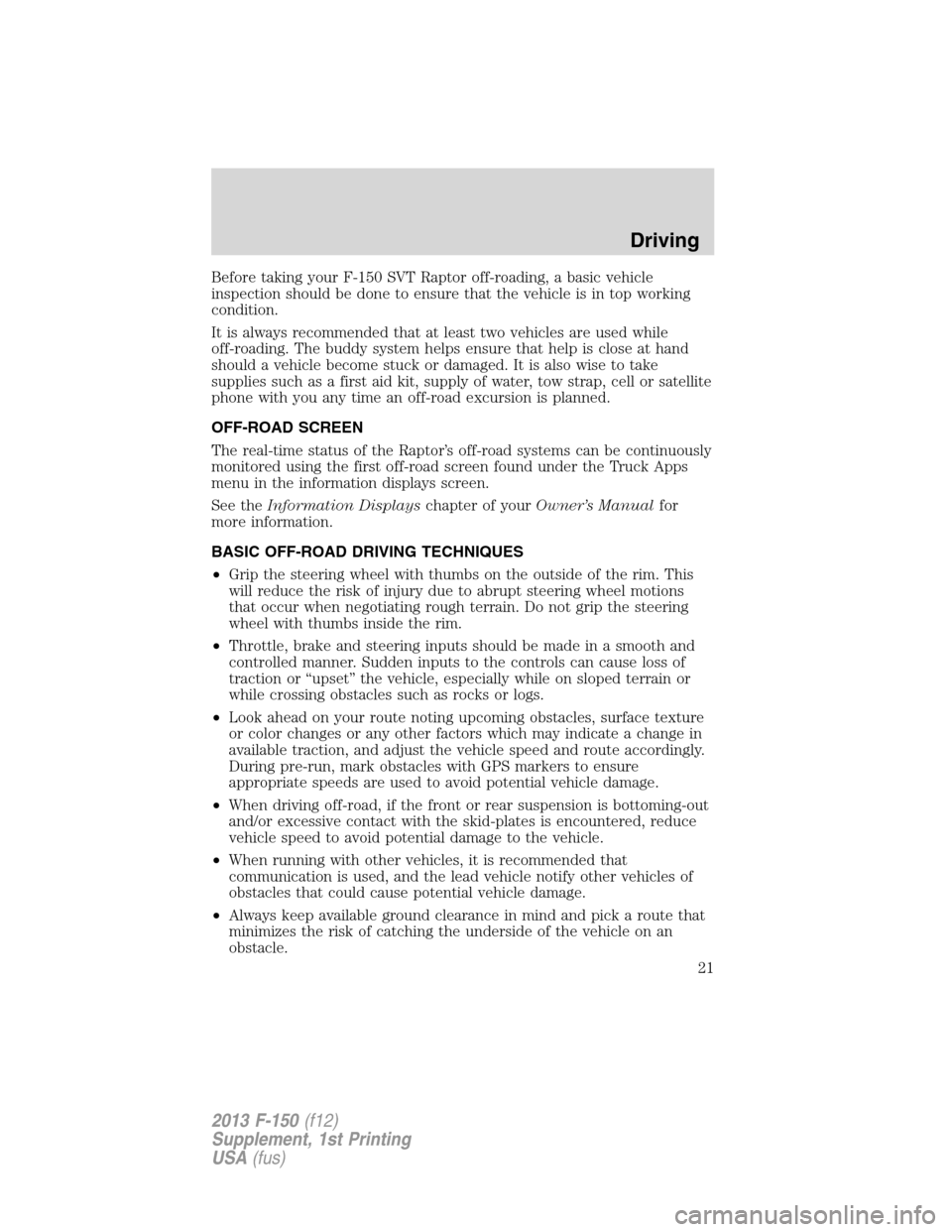
Before taking your F-150 SVT Raptor off-roading, a basic vehicle
inspection should be done to ensure that the vehicle is in top working
condition.
It is always recommended that at least two vehicles are used while
off-roading. The buddy system helps ensure that help is close at hand
should a vehicle become stuck or damaged. It is also wise to take
supplies such as a first aid kit, supply of water, tow strap, cell or satellite
phone with you any time an off-road excursion is planned.
OFF-ROAD SCREEN
The real-time status of the Raptor’s off-road systems can be continuously
monitored using the first off-road screen found under the Truck Apps
menu in the information displays screen.
See theInformation Displayschapter of yourOwner’s Manualfor
more information.
BASIC OFF-ROAD DRIVING TECHNIQUES
•Grip the steering wheel with thumbs on the outside of the rim. This
will reduce the risk of injury due to abrupt steering wheel motions
that occur when negotiating rough terrain. Do not grip the steering
wheel with thumbs inside the rim.
•Throttle, brake and steering inputs should be made in a smooth and
controlled manner. Sudden inputs to the controls can cause loss of
traction or “upset” the vehicle, especially while on sloped terrain or
while crossing obstacles such as rocks or logs.
•Look ahead on your route noting upcoming obstacles, surface texture
or color changes or any other factors which may indicate a change in
available traction, and adjust the vehicle speed and route accordingly.
During pre-run, mark obstacles with GPS markers to ensure
appropriate speeds are used to avoid potential vehicle damage.
•When driving off-road, if the front or rear suspension is bottoming-out
and/or excessive contact with the skid-plates is encountered, reduce
vehicle speed to avoid potential damage to the vehicle.
•When running with other vehicles, it is recommended that
communication is used, and the lead vehicle notify other vehicles of
obstacles that could cause potential vehicle damage.
•Always keep available ground clearance in mind and pick a route that
minimizes the risk of catching the underside of the vehicle on an
obstacle.
Driving
21
2013 F-150(f12)
Supplement, 1st Printing
USA(fus)
Page 23 of 39
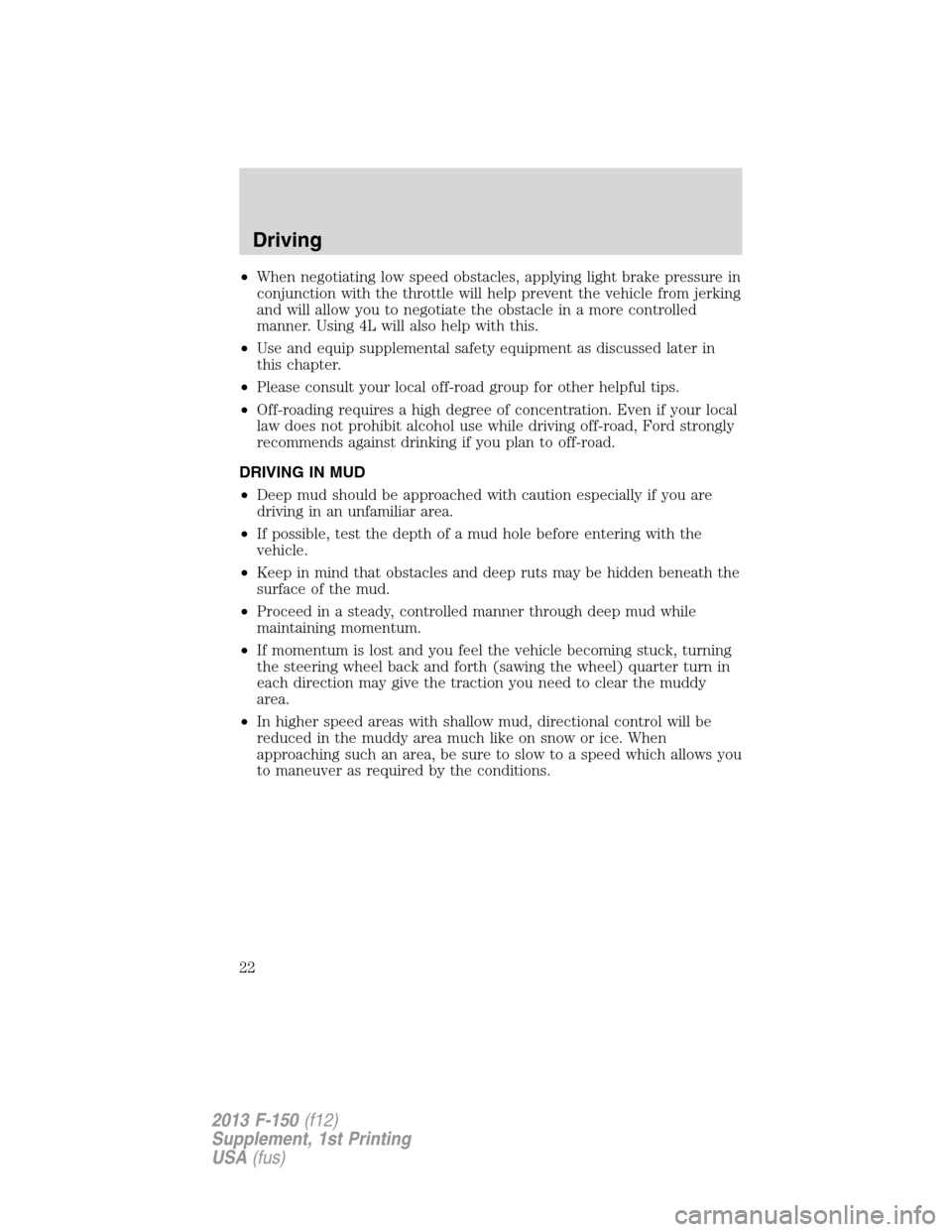
•When negotiating low speed obstacles, applying light brake pressure in
conjunction with the throttle will help prevent the vehicle from jerking
and will allow you to negotiate the obstacle in a more controlled
manner. Using 4L will also help with this.
•Use and equip supplemental safety equipment as discussed later in
this chapter.
•Please consult your local off-road group for other helpful tips.
•Off-roading requires a high degree of concentration. Even if your local
law does not prohibit alcohol use while driving off-road, Ford strongly
recommends against drinking if you plan to off-road.
DRIVING IN MUD
•Deep mud should be approached with caution especially if you are
driving in an unfamiliar area.
•If possible, test the depth of a mud hole before entering with the
vehicle.
•Keep in mind that obstacles and deep ruts may be hidden beneath the
surface of the mud.
•Proceed in a steady, controlled manner through deep mud while
maintaining momentum.
•If momentum is lost and you feel the vehicle becoming stuck, turning
the steering wheel back and forth (sawing the wheel) quarter turn in
each direction may give the traction you need to clear the muddy
area.
•In higher speed areas with shallow mud, directional control will be
reduced in the muddy area much like on snow or ice. When
approaching such an area, be sure to slow to a speed which allows you
to maneuver as required by the conditions.
Driving
22
2013 F-150(f12)
Supplement, 1st Printing
USA(fus)
Page 24 of 39
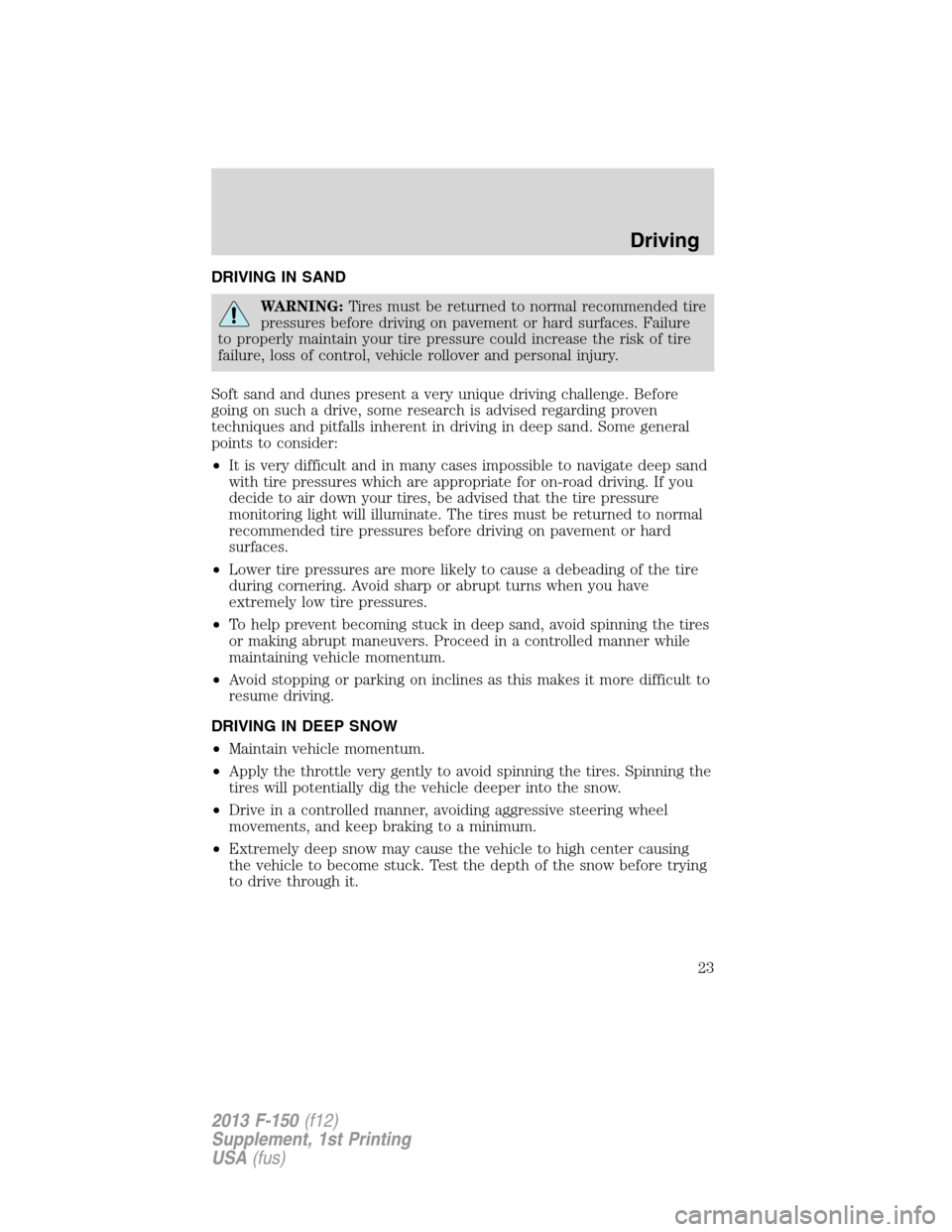
DRIVING IN SAND
WARNING:Tires must be returned to normal recommended tire
pressures before driving on pavement or hard surfaces. Failure
to properly maintain your tire pressure could increase the risk of tire
failure, loss of control, vehicle rollover and personal injury.
Soft sand and dunes present a very unique driving challenge. Before
going on such a drive, some research is advised regarding proven
techniques and pitfalls inherent in driving in deep sand. Some general
points to consider:
•It is very difficult and in many cases impossible to navigate deep sand
with tire pressures which are appropriate for on-road driving. If you
decide to air down your tires, be advised that the tire pressure
monitoring light will illuminate. The tires must be returned to normal
recommended tire pressures before driving on pavement or hard
surfaces.
•Lower tire pressures are more likely to cause a debeading of the tire
during cornering. Avoid sharp or abrupt turns when you have
extremely low tire pressures.
•To help prevent becoming stuck in deep sand, avoid spinning the tires
or making abrupt maneuvers. Proceed in a controlled manner while
maintaining vehicle momentum.
•Avoid stopping or parking on inclines as this makes it more difficult to
resume driving.
DRIVING IN DEEP SNOW
•Maintain vehicle momentum.
•Apply the throttle very gently to avoid spinning the tires. Spinning the
tires will potentially dig the vehicle deeper into the snow.
•Drive in a controlled manner, avoiding aggressive steering wheel
movements, and keep braking to a minimum.
•Extremely deep snow may cause the vehicle to high center causing
the vehicle to become stuck. Test the depth of the snow before trying
to drive through it.
Driving
23
2013 F-150(f12)
Supplement, 1st Printing
USA(fus)
Page 25 of 39
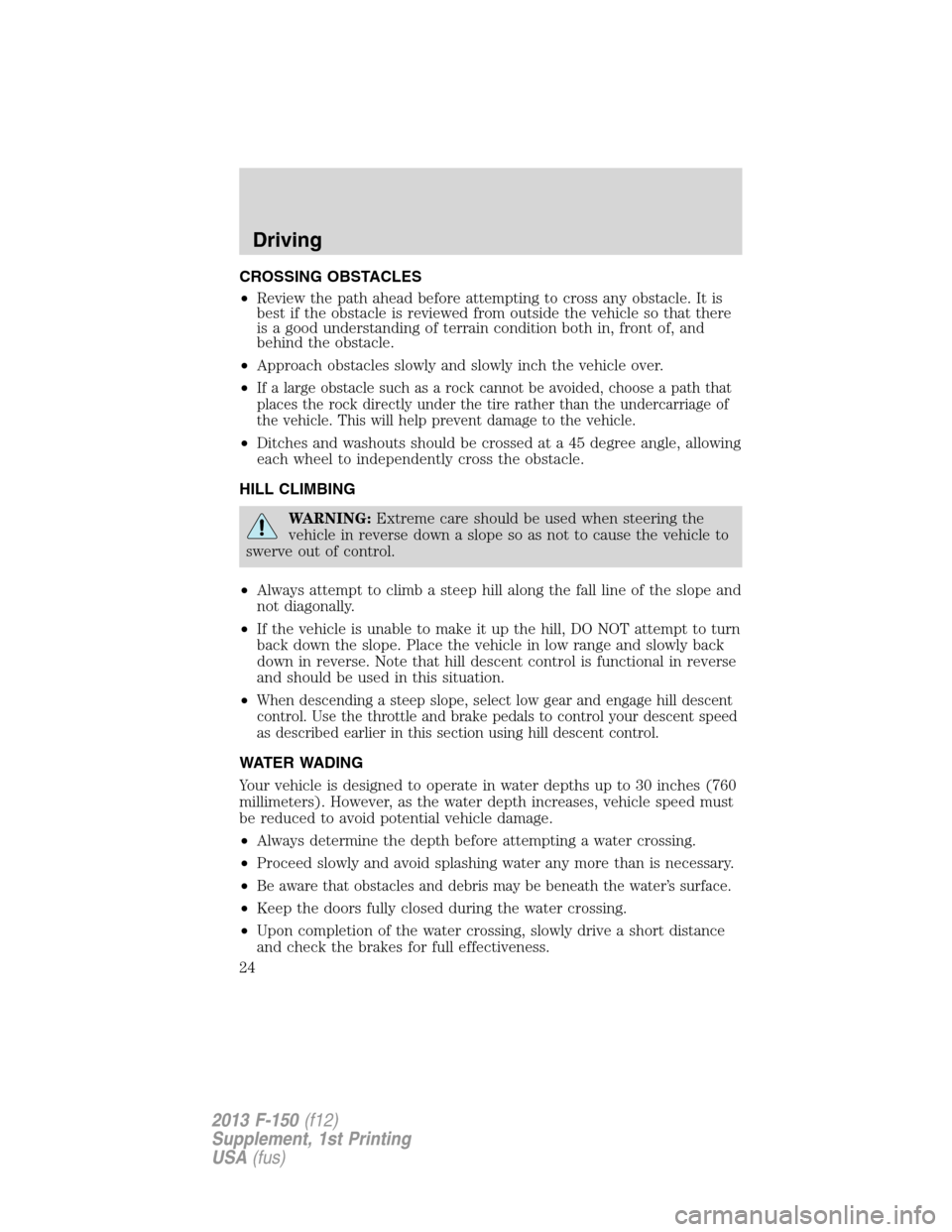
CROSSING OBSTACLES
•Review the path ahead before attempting to cross any obstacle. It is
best if the obstacle is reviewed from outside the vehicle so that there
is a good understanding of terrain condition both in, front of, and
behind the obstacle.
•Approach obstacles slowly and slowly inch the vehicle over.
•
If a large obstacle such as a rock cannot be avoided, choose a path that
places the rock directly under the tire rather than the undercarriage of
the vehicle. This will help prevent damage to the vehicle.
•Ditches and washouts should be crossed at a 45 degree angle, allowing
each wheel to independently cross the obstacle.
HILL CLIMBING
WARNING:Extreme care should be used when steering the
vehicle in reverse down a slope so as not to cause the vehicle to
swerve out of control.
•Always attempt to climb a steep hill along the fall line of the slope and
not diagonally.
•If the vehicle is unable to make it up the hill, DO NOT attempt to turn
back down the slope. Place the vehicle in low range and slowly back
down in reverse. Note that hill descent control is functional in reverse
and should be used in this situation.
•
When descending a steep slope, select low gear and engage hill descent
control. Use the throttle and brake pedals to control your descent speed
as described earlier in this section using hill descent control.
WATER WADING
Your vehicle is designed to operate in water depths up to 30 inches (760
millimeters). However, as the water depth increases, vehicle speed must
be reduced to avoid potential vehicle damage.
•Always determine the depth before attempting a water crossing.
•Proceed slowly and avoid splashing water any more than is necessary.
•
Be aware that obstacles and debris may be beneath the water’s surface.
•Keep the doors fully closed during the water crossing.
•Upon completion of the water crossing, slowly drive a short distance
and check the brakes for full effectiveness.
Driving
24
2013 F-150(f12)
Supplement, 1st Printing
USA(fus)